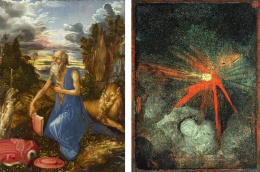(Unless otherwise stated, the copyright of the materials included belong to Jan Woreczko & Wadi.)
Św. Hieronim na pustyni (Dürer, obraz)
Z Wiki.Meteoritica.pl
Spadek meteorytu Ensisheim na obrazie Dürera?
Dzieło genialnego niemieckiego artysty renesansu Albrechta Dürera „Św. Hieronim na pustyni” (St. Jerome in the Wilderness) to dwustronny(!) obraz olejny na desce. Na frontowej stronie obrazu przedstawiono św. Hieronima na pustyni (raczej pustelni, pustkowiu) otoczonego przypisywanymi mu atrybutami: oswojonym lwem, szatami i kapeluszem kardynalskim oraz księgami. Obraz obfituje w szczegóły i perfekcyjne detale. To niewielki dzieło 23×17 cm powstało około 1496 roku, obecnie znajduje się w zbiorach Galerii Narodowej w Londynie (National Gallery in London). Motyw św. Hieronima w pustelni był bardzo popularny w malarstwie epoki. Podobnie zatytułowany i podobny obraz wyszedł spod pędzla Leonaro da Vinci.
Interesuje nas druga strona obrazu. Na odwrocie obrazu znajduje się coś co wygląda jak kometa lub spadek meteorytu! Historycy sztuki proponują różne hipotezy dotyczące inspiracji artysty. Jedne z nich mówią o przedstawieniu komety widocznej w lutym 1491 roku lub późniejszej obserwowanej w 1493 roku (więcej szczegółów na Wikipedii). Natomiast znana badaczka historii meteorytyki Ursula Marvin, zaproponowała hipotezę, że Albrecht Dürer namalował wizję spadku meteorytu Ensisheim[1] z 7 listopada 1492 roku w Alzacji (Marvin 1992).
Za Wikipedią:
(…) Back panel of the painting
On the reverse of this painting is an image of what appears to be a meteor/meteorite or comet. Dürer's inspiration may have been the depictions of comets in the Nuremberg Chronicle of 1493. However, those woodcuts are highly stylized, and are not intended to show historical comets, whereas Dürer's image has the feel of an actual observation, as does the blazing star in Dürer's enigmatic engraving Melencolia I, published in 1514.
If Dürer's images do represent actual celestial objects, then there are three possible candidates. The first is the Comet of 1491. Dr Sten Odenwald said that it "allegedly came to within 0.0094 AU on 1491 Feb. 20.0 TT, but the orbit of this comet is very uncertain"; NASA's website agrees with Odenwald's comment on the orbit. The second is the Ensisheim meteorite. This was suggested by Ursula B. Marvin ('The meteorite of Ensisheim – 1492 to 1992', (1992)), in relation to Melencolia I. This object fell in Alsace on 7 November 1492. The third is the comet of 1493, mentioned in the chronological section of Sir David Brewster's The Edinburgh Encyclopædia, which said it was: "seen before and after passing its meridian."
Opis tylnej strony obrazu na stronie The National Gallery w Londynie:
(…) The reverse depicts a dark sky and what might be planets, a comet or meteorite or an eclipse, possibly a reference to Saint John the Evangelist’s descriptions of the end of the world as recorded in the Book of Revelation.
Przeglądając artystyczne wizje spadku tego meteorytu znajdujące się m.in. w historycznych dziełach Schedel (1493) i Schilling (1513), trudno odmówić dużej dozy prawdopodobieństwa hipotezie, że Dürer naprawdę namalował spadek meteorytu!
Bibliografia
- Marvin Ursula B., (1992), The meteorite of Ensisheim: 1492 to 1992, Meteoritics, vol. 27(1), 1992, s. 28-72.[1][2] Plik doi; plik aDs.
- Schedel Hartmann, Wolgemut Michael, (1493), Liber cronicarum cum figuris ymaginibus ab inicio mundi (Nuremberg Chronicle), Nürnberg, July 12, 1493, (wersja łacińska), ss. 326.[3][1] Plik DjVu; plik zLib; plik pLib.
- Schilling Diebold der Jüngere, (1513), Luzerner Chronik, Lucerne 1513 (ilustracje).[4] Plik DjVu.
Przypisy
Zobacz również
- dzieła: Schedel (1493), Schilling (1513)
Linki zewnętrzne
- Wikipedia (EN) – Albrecht Dürer ● St. Jerome in the Wilderness (Dürer)
- The National Gallery – Albrecht Dürer | Saint Jerome | NG6563

